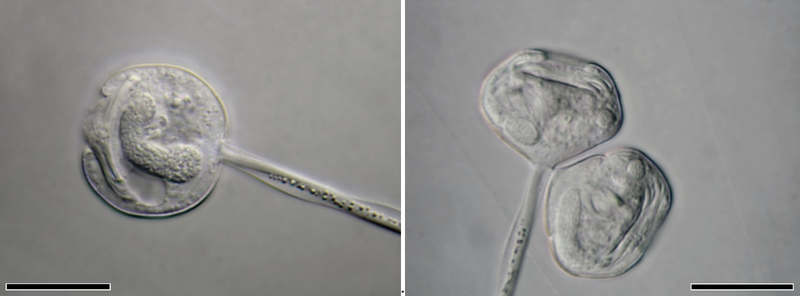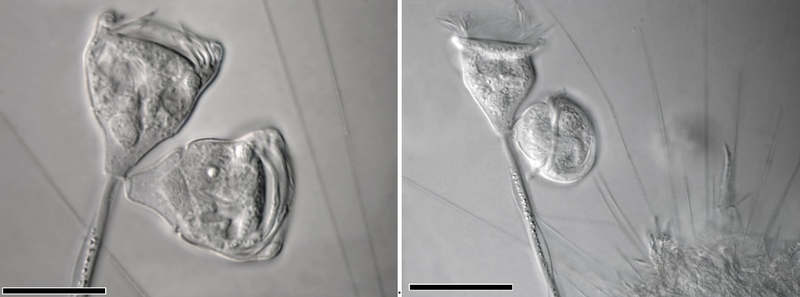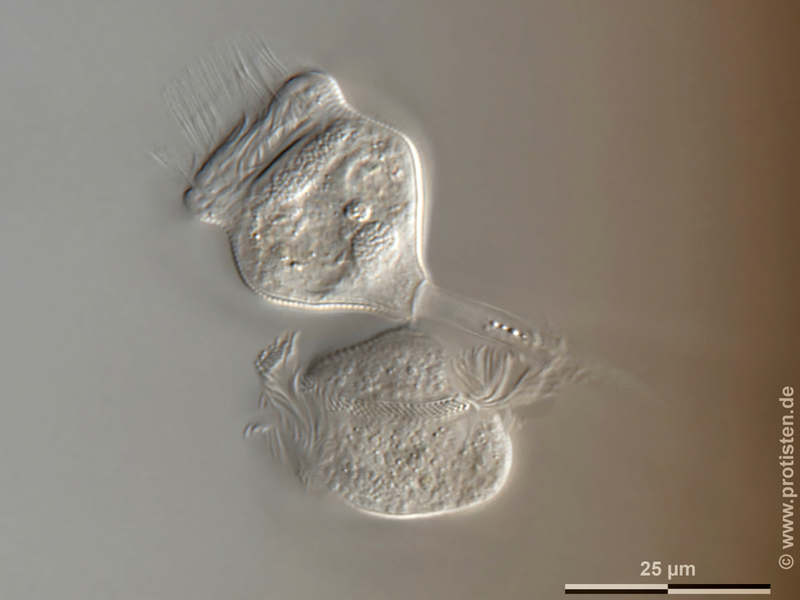Observations on
Vorticella Linneaus 1767
Most likely ID: n. a.
Synonyms: n. a.
EOL Phylogenetic tree: Vorticella
Binary fission in Vorticella

Fig. 1: Vorticella spec. shortly before binary fission. Fig. 2: Vorticella spec. shortly after binary fission.
Central macro nucleus, contractile vacuole. Scale bar Scale bar indicates 25 µm.
indicates 25 µm.

Fig. 3: Vorticella spec., the adoral zone of membranelles Fig. 4: Vorticella spec. The new cell has balled up and is
arises from the newly formed cell. Scale bar indicates already showing the appearance of a swarmer.
25 µm. Scale bar indicates 25 µm.

Fig. 5: Another detailed view on a swarmer of Vorticella spec. Scale bar indicates 25 µm. Sample from a tropical freshwater aquarium.
Conversion to the swarmer state
As can be seen in Fig. 1, Peritrichia fold their peristome before starting binary fission. In Fig. 2 and Fig. 3 the initial
of the transitory ciliary girdle (telotroch) can be seen, the notches at the end of the outline of the conical part of the cell
body. A bulging constriction in the cortex (the complex cell cover of the ciliates) evolves, from which lots of cilia are slowly
sprouting, which then deliver the propulsion in the migration phase. In Fig. 4, the ring-shaped bead can be seen clearly. It was
astonishing to observe how both cells were synchronized to extend their adorale zones of membranelles (AZM) of their peristomes.
While this makes sense for the cell that keeps the stalk, the other cell, which has to swim away, has to retract the AZM again
to get ready for the migration phase.
In the course of further observation, I could see the swarmer getting a spherical outline, and retracting its AZM. Fig. 4 and 5
show the telotroch clearly developed, the cilia are appr. 10 µm long. At this stage, the ciliary ring undulated slowly,
sometimes twitching, with a period of four to five seconds. At the end of this process, the cilia had grown up to a length of
approx. 8 µm. The initially quite atactic movements of the cilia (very jerky undulation of the ciliary ring) became increasingly
coordinated and faster over time, the undulation frequency rose to once per second.
Suddenly it was as if the engine ran warm. The fast movements of the cilia could no longer be observed separately, the cell tore
violently on the thread-shaped connection, and a short time later it had loosened.
When a swarmer hit roots
The landing of a Vorticella swarmer with subsequent development of the stalk is also an interesting spectacle. In the swarmer
state, the cell moves so that the retracted peristome shows backwards. If the cell during its underwater flight encounters a substrate
that is suitable for the adhesion, it begins to press – stabilized by the propulsion of the telotroch. In this phase, the swarmer
looks like a humming-top, which has a slightly too little momentum and therefore begins to stagger. After a few minutes, the initial
of the stalk has formed. As soon as the attachment is stable, the cilia ring of the telotroch stops undulating. Its retrofitting begins
very quickly, but it takes some time for the ciliary girdle to be fully degenerated. The Figures 6 to 11 show the entire cycle from
landing to the adhesion, the subsequent development of the stalk, up to a renewed conversion into the swarmer status, and finally the
detachment from the stalk.

Fig. 6: Vorticella spec. shortly after fastening on the substratum. Fig. 7: Eight minutes later: The initial stalk has been formed,
the telotroch is being degenerated. Fig. 8: 17 minutes later: The notch (arrowhead) represents the rest of the telotroch.
Fig. 9: 50 minutes later: The initial notch of the newly forming telotroch (arrowhead) is visible again. Fig. 10: 90 minutes
later: The development of the new telotroch has been completed. Fig. 11: 100 minutes later: The remaining stalk (arrowhead),
together with the heliozoan Raphidocystis tubifera. Scale bar indicates 25 µm.
| |
Download |
Observations and © Wolfgang Bettighofer 2009 - 2023 |